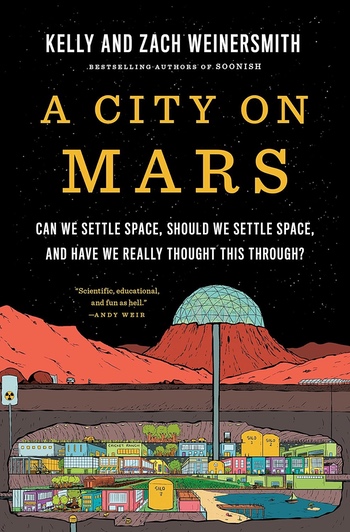Review: A City on Marsby Jeff Foust
|
| Even advocates of space settlement would agree that there is still a lot to do to enable humans to live permanently in space, and that there is, for now, not much work being done many of those areas. |
That dedication/warning may be warranted. Rather than another book preaching the gospel of humanity’s future on the Moon, Mars, or other space settlements, A City on Mars is a cautionary, skeptical tale. There’s little reason for humans to live in space, many challenges for them to do so, and even broader risks if humanity expands into the solar system, they conclude.
Much of the book focuses on the challenges of humans living long-term in space. They range from the obvious physiological issues from zero or reduced gravity and radiation, as well as closed-loop life support, reproduction (the obligatory discussion of sex in space), and psychology. There are also discussions about how to build and maintain habitats and the legal and policy issues of off-world settlements. The chapters are thoroughly researched but with a dollop or two (or more) of humor.
Even advocates of space settlement would agree that there is still a lot to do to enable humans to live permanently in space, and that there is, for now, not much work being done many of those areas. For example, speaking at the Beyond Earth Summit earlier this month, Bhavya Lal, a former NASA associate administrator who led its Office of Technology, Policy, and Strategy, noted that if NASA was serious about supporting space settlement, it would need to invest more in some technologies, like closed-loop life support and in situ resource utilization. There are additional areas, she said, that NASA is not doing at all that would be needed, like human reproduction in space and the effects of partial gravity on the human body.
Bigger clashes with space settlement advocates, though, may come elsewhere in the book. In the book’s first chapter, the Weinersmiths swiftly and bluntly reject most of the arguments made for human settlements beyond Earth: giving humanity a place to expand, transferring industries off Earth, accessing space resources or space-based solar power, and more. The only arguments they considerable reasonably acceptable is to bring work to one day allow humans to live beyond Earth to protect the species (the “cathedral of survival”) or simply because people want to do it. Moreover, they’re worried that races to establish space settlements, like in the most desirable places on the Moon, could led to conflict.
| “But we just cannot convince ourselves that the usual arguments for space settlements are good. Space settlement will be much harder than it is usually portrayed, without obvious economic benefits,” they write near the end of the book. |
Some of those arguments in the book are stronger than others. The various biological and physical challenges of long-duration spaceflight are understood and, as noted above, recognized even by those who support settlement. But space settlement as an instigator for conflict on Earth or space is more difficult to accept, sounding instead like a plot point from For All Mankind. (The policy sections of the book are weaker than the rest, with some misunderstandings about the Artemis Accords and an odd argument that existing treaties regarding the rescue and return of astronauts would not apply to commercial space travelers because they are not “astronauts,” a claim they based in part on a now-defunct FAA commercial space wings program.)
“But we just cannot convince ourselves that the usual arguments for space settlements are good. Space settlement will be much harder than it is usually portrayed, without obvious economic benefits,” they write near the end of A City on Mars. “Attempting space settlement now may increase the likelihood of conflict on Earth in the short term and ultimate increase human existential risk.”
The Weinersmiths note that they are not opposed to space settlement per se, only that they are not yet convinced that its benefits are worth its risks and the work to overcome the challenges. It’s something that might make more sense in the more distant future, they argue. That view is not that different from the current state of play: despite bold claims, like Elon Musk predicting a million people living on Mars by mid-century, there’s little serious progress towards human settlement beyond Earth, given the difficulties and lack of a compelling case for doing so. Space settlements may one day come, just not in the immediate future; enough time, perhaps, to assuage any hurt feelings among the space settlement community from the book.
Note: we are using a new commenting system, which may require you to create a new account.
